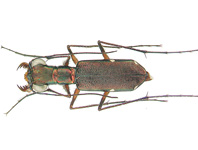Abstract
Identifying and describing fossil thrips (Thysanoptera) sometimes touches the limits of feasibility. Complications handling these tiny fossils are not only caused by their size, their position or fragmentary nature, but also by the state and condition of the matrices surrounding them. Due to poor preservation in some matrices (such as lime, potash and lignite) their identification often remains uncertain (Ulitzka 2015a). Amber, however, considered as a window on times past (Gröhn et al. 2015), presents a wide range of insect inclusions in excellent condition. Nevertheless, many problems can impede our visibility through this ‘window’. Fissures, opacity or clouding in the fossil resin, as well as inclusions or bubbles of air, can cover specific characteristics of an included specimen. Curvature of the amber surface results in optical distortions that can impede a reliable assessment of certain features, and the deeper an inclusion is in the amber the greater are the problems. For these reasons cutting or grinding the amber as close as possible to a specimen is essential. In the future, synchrotron X-ray microtomography may be an alternative (Henderickx et al. 2012; van de Kamp et al. 2014), but at present is too complex and expensive.
References
Gröhn, C., Hornemann, M., Joger, U., Koch, A., Kosma, R., Krüger, F.J., Vahldiek, B.-W., Wilde, V. & Zellmer, H. (2015) Zeitkapsel Bernstein – Lebewesen vergangener Welten. Verlag Dr. F. Pfeil, München, 97 pp.
Henderickx, H., Tafforeau, P. & Soriano, C. (2012) Phasecontrast synchrotron microtomography reveals the morphology of a partially visible new Pseudogarypus in Baltic amber (Pseudoscorpiones: Pseudogarypidae). Palaeontologia Electronica, 15 (2), 1–11. Available form:
http://palaeo-electronica.org/content/2012-issue-2-articles/252-pseudogarypus-synchrotron (accessed 3 November 2016)van der Kamp, T., dos Santos Rolo, T., Baumbach, T. & Krogmann, L. (2014) Scanning the Past – Synchrotron X-ray microtomography of fossil wasps in amber. Entomologie heute, 26, 151–160.
Mound, L.A. (1968) A review of R.S. Bagnall’s Thysanoptera collection. Bulletin of the British Museum (Natural History) Entomology, 11, 1–181.
Mound, L.A. & O’Neill, K. (1974) Taxonomy of Merothripidae, with ecological and phylogenetic considerations (Thysanoptera). Journal of Natural History, 8, 481–509.
https://doi.org/10.1080/00222937400770411Priesner, H. (1924) Bernstein-Thysanopteren. Entomologische Mitteilungen, 13, 130–151.
Schliephake, G. (2001) Thysanoptera (Insecta) of the Tertiary amber of the Museum of the Earth, Warsaw, with keys to the species of the Baltic and Bitterfeld amber. Prace Muzeum Ziemi, 46, 17–39.
Schliephake, G. (2003) Fossile Thysanoptera im Baltischen Bernstein aus Kiesgruben westlich von Sarstedt (Niedersachsen). Entomologische Nachrichten und Berichte, 47 (3–4), 179–180.
ThripsWiki (2016) ThripsWiki - providing information on the world’s thrips. Available from: http://thrips.info/wiki/Merothripidae (accessed 3 November 2016)
Ulitzka, M.R. (2015a) Two new species of Aeolothripidae from Baltic Tertiary amber (Insecta: Thysanoptera). Palaeodiversity, 8, 89–94.
Ulitzka, M.R. (2015b) Praemerothrips hoodi Priesner, 1929 and Merothrips balticus sp. nov. - Two new fossils of thrips from Baltic Tertiary amber (Thysanoptera: Merothripidae). Entomologische Zeitschrift, 125 (4), 213–216.

